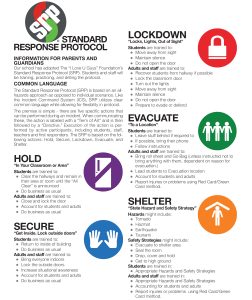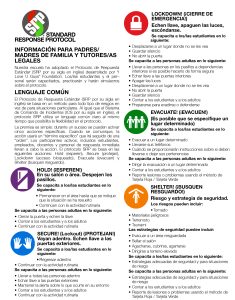Standard Response Protocol
The “Standard Response Protocol is courtesy of the “I Love U Guys” Foundation
Easy to understand. Easy to implement.
A uniform, planned, and practiced response to any incident is the foundation of a safe school. Safe business. Safe community. The SRP is action-based, flexible, and easy to learn. It rationally organizes tactics for response to weather events, fires, accidents, intruders and other threats to personal safety.
The SRP’s development is ever-evolving, created with extensive collaboration between experts such as first responders, public safety, school, districts, and communities. Its tactics are data-driven, researched and based on experience and contemporary practices.
On the Same Page. Everyone.
The benefits of SRP become quickly apparent. By standardizing the vocabulary, all stakeholders can understand the response and status of the event.
For students, this provides continuity of expectations and actions throughout their educational career. For teachers, this becomes a simpler process to train and drill. For communities, it leverages the growing adoption of the protocols from residents of all ages. For first responders, the common vocabulary and protocols establish a greater predictability that persists through the duration of an incident.
People easily understand the practices and can reinforce the protocol. Additionally, this protocol enables rapid response determination when an unforeseen event occurs.
SRP is Action Based
The Standard Response Protocol (SRP) is based on the response to any given situation not on individual scenarios. Like the Incident Command System (ICS), SRP demands a specific vocabulary but also allows for great flexibility. The premise is simple – these five specific actions that can be performed during an incident. When communicating these, the action is labeled with a “Term of Art” and is then followed by a “Directive.” Execution of the action is performed by active participants.
 |
Hold is followed by the Directive: “In Your Room or Area” and is the protocol used when hallways need to be kept clear of occupants. |
 |
Secure is followed by the Directive: “Get Inside. Lock Outside Doors” and is the protocol used to safeguard people within the building. |
 |
Lockdown is followed by “Locks, Lights, Out of Sight” and is the protocol used to secure individual rooms and keep occupants quiet and in place. |
 |
Evacuate may be followed by a location, and is used to move people from one location to a different location in or out of the building. |
 |
Shelter and state the Hazard and Safety Strategy for group and self protection. |
Standard Response Protocol Reference Guide for Parents
Guía de referencia del protocolo de respuesta estándar para padres


